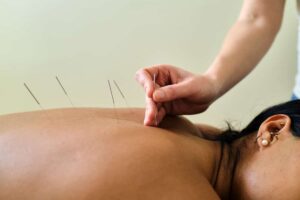A very common question I’m asked, is “how does acupuncture work?” This can be a complicated question to answer, especially from a Chinese medical theory perspective. It involves the flow of Qi (life’s vital energy) through meridians, the balance of yin and yang, and how this affects organs and other tissues in the body, both physically and energetically. In Western societies, these topics can cause a lot of glossy eyes and disbelief in the practice of acupuncture, as things like Qi, yin, and yang are not scientifically proven how they work, or if they even exist. However, if we explain it in terms that most of us are familiar with, it’s much easier to understand.
Why did you put the needle there?
It’s all about blood flow. When I put acupuncture needles in your body, I target specific areas which may be injured, inflamed, or painful, which may be referred to as trigger points. The body sees the needles as foreign objects and it does not want them to be there. So the body creates an immune response, increasing circulation, and flooding the areas with blood. This blood brings new cells to the area to help heal any damaged tissue and flush out debris that may be in the area, allowing the body to heal itself in a more effective and efficient way. I may also include points that are not near the areas of pain but have been shown to help the areas of pain. These points are used based in Traditional Chinese Medicine (TCM) theory. For example, when patients come in with neck pain and headaches, I don’t just needle the head and neck, I may also put needles in their hands and feet. If you think about pain as stagnant Qi or blood, we use these distal points on the hands and feet to break up the stagnation and draw the energies and blood away from the head to help clear pain.
Benefits of acupuncture for pain management
- Decreased pain levels due to the release of endorphins, the body’s natural pain-killing chemicals.
- Increased healing and recovery from injury due to increased circulation.
- Better moods and sleep due to the regulation of serotonin and melatonin, which respectively give you energy or relaxes you.
You’re different from other acupuncturists I’ve seen
I must note that I’m not trying to downplay the effectiveness of traditional Chinese medicine and acupuncture when applied using the theories of meridians, Qi, yin, and yang. This is what this medicine is based in, and how I learned it. Techniques based on these principles not only work to treat pain but also internal medical issues as well, like anxiety and depression, insomnia, digestive disorders, men’s and women’s health, along with many other medical issues. If it’s not an emergency, acupuncture can often help.
As I said earlier, I still use points-based in TCM theory, and may not always needle where the pain is. However, from experience, when patients come in with neck or back pain, they expect those areas to receive attention, and if they don’t get it, patients often feel like the practitioner wasn’t listening, or didn’t give them proper treatment. This is why I practice the way I do. I can target the areas which you feel need attention, but also use points whose actions may benefit you as well.
Questions or Comments for the Acupuncturist
I hope this has been informative and has helped you understand a little bit about how acupuncture works and can help with pain management. I will try to talk about different topics on a monthly basis associated with acupuncture, why and how it can work, as well as techniques you may be able to use at home to help with your pains. However, I would also like to hear from you, the patient. Is there anything you want to know about acupuncture? Any specific topics of conversation you would like me to weigh in on or questions you want to be answered? If so, let me know next time I see you, or leave a note for me at the office. I’m all for ideas from the people who are seeking this modality for improved health and wellness. Let’s keep the conversations going. I’ll try to answer any questions to the best of my ability. Just try to keep them related to pain management or musculoskeletal injury. You can also fill out the contact form and ask questions in the comment box.






